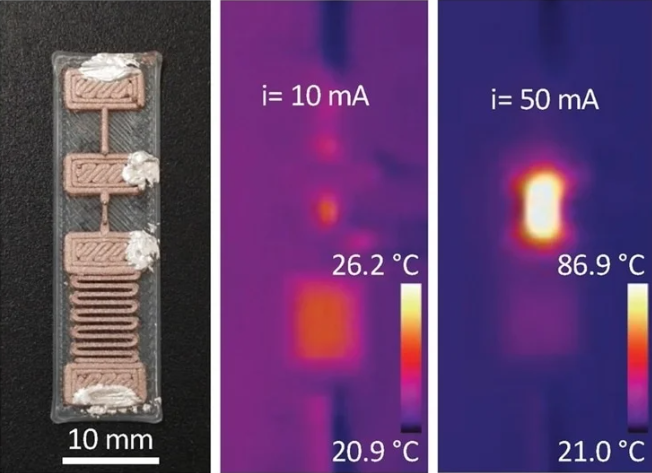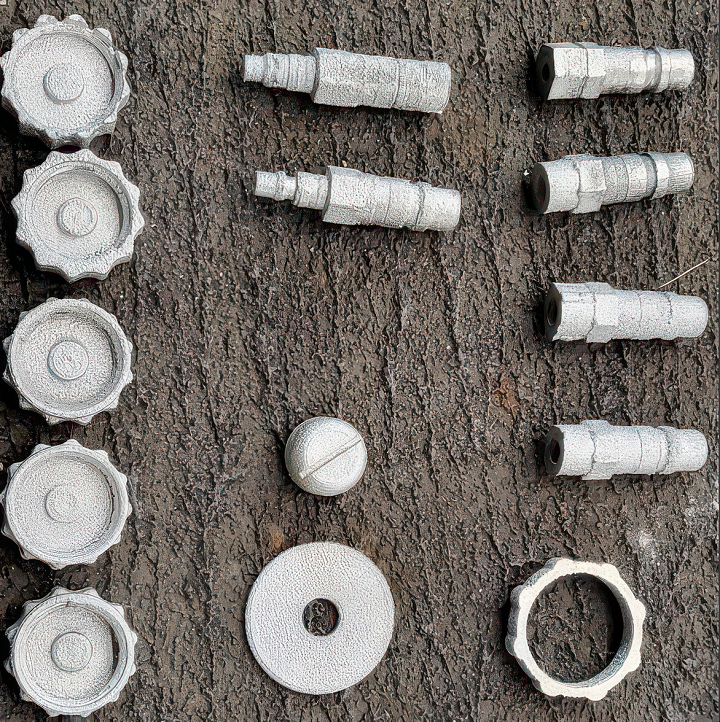3D Printing News Briefs, November 9, 2024: Concept Car, Afloat 3D Printing, & More
In today’s 3D Printing News Briefs, we’ll start with business, as Anisoprint appointed AM industry veteran Tuan TranPham as President of the Americas and APAC. Then we’ll move onto automotive news from McLaren and Divergent and HP and Subaru, before switching to afloat 3D printing for the US Navy enabled by ADDiTEC. Finally, 3D printed semiconductor-free transistors by MIT researchers could one day revolutionize electronics manufacturing.
Anisoprint Appoints Tuan TranPham President of the Americas and APAC
Composite 3D printing company Anisoprint has appointed AM industry veteran Tuan TranPham as its President of the Americas and Asia Pacific (APAC). The AMUG Dino, who is the most followed 3D printing professional on LinkedIn, has over 20 years of experience in the AM sector, fostering important partnerships, developing innovative solutions, and leading revenue strategies at some of the most well-known companies in our industry, including 3D Systems, Stratasys, and Desktop Metal; most recently, he was Chief Revenue Officer at Azul 3D. TranPham’s expertise aligns with Anisoprint’s mission to advance continuous fiber 3D printing, and he will help drive the company’s strategic growth and enhance its market presence across several industries, including industrial, consumer, automotive, aerospace, and oil & gas. In his new role, he will work to strengthen customer relationships, refine sales strategies, and speed up commercialization of Anisoprint’s advanced AM technologies. TranPham’s appointment is a major milestone for the company, which is committed to growing its global market reach.
“I am excited to join Anisoprint, an experienced composite 3D printing company with amazing potential and growth. I believe Anisoprint’s Composite Fiber Co-extrusion (CFC) technology will reinvigorate the 3D printing market and give our customers better and improved desktop solutions sub-US$ 50,000 and I am thrilled to be a part of this new revolutionary company,” TranPham said. “I am excited to be working with our existing world-class channel partners and customers, while looking forward to building relationships with new channel partners and customers.”
To learn more about Anisoprint, you can meet the company at its Formnext booth C.11 in Hall 12.1, November 19-22.
McLaren Automotive Partners with Divergent for Advanced Suspension
McLaren Automotive is collaborating again with Divergent Technologies to develop advanced suspension hardware for its new McLaren W1 supercar, succeeding the F1 and P1 models. McLaren, the largest part of the McLaren Group, uses Divergent’s AM technology to make components that will improve driver engagement and vehicle performance, including a Formula 1-inspired front suspension system that’s integrated directly into the Aerocell carbon fibre monocoque. 3d printing enables excellent stiffness and durability in important structural components, like the front upright, aero form lower wishbone, and front upper wishbones, the latter of which are visible externally on the W1 supercar. McLaren says that Divergent’s technology “has been instrumental” in developing in creating its suspension systems, and that their partnership makes it possible for quick design iteration, which helps speed up the development of the suspension hardware.
“We are proud to partner with McLaren on their newest engineering marvel, the W1,” said Divergent Technologies CEO, Founder, and Chairman Kevin Czinger. “The suspension hardware designed and manufactured by Divergent has enabled the McLaren team to push the boundaries of what is possible in this digital manufacturing age of supercar production.”
Subaru Uses HP Jet Fusion to 3D Print Concept Car Parts

L-R: A hangar with a shape that takes advantage of the unique features of 3D printing without restrictions like the direction of mold removal; a lockable locker for temporary storage of car keys when surfing or enjoying other activities
Three Tokyo companies—HP Japan Inc., Subaru Corporation, and DMM.com’s DMM.make 3D Print division—came together to create 3D printed parts for a concept car. The name of the SUBARU LEGACY OUTBACK BOOSTGEAR PACKAGE, which was exhibited at Tokyo Auto Salon 2024, represents a “boost” to help customers get places and do things they couldn’t before, and features playful, decorative, removable parts made with HP’s Jet Fusion technology to ensure the necessary mass production capabilities. By using 3D printing, molds weren’t needed, so the team was able to develop uniquely-shaped custom parts within a limited timeframe using HP 3D High Reusability PA 12 (Nylon 12) to achieve the proper strength, heat, and weather resistance properties. Subaru had the future in mind when designing the concept car, with an aim to solve manufacturing challenges like mold removal and inventory management by using HP’s Jet Fusion. Together, four types of removable parts were made for the car’s over fender, including a part with a magnet for attaching tools and a part that becomes a speaker when a smartphone is inserted.
“We automotive designers have always been constrained by molds, struggling with issues like part separation. However, by using 3D printing, we are freed from all issues such as the angle of mold removal and the appearance of parting lines, significantly enhancing design freedom,” said Kanenori Susaki, Manager, Accessories Planning Department, Parts & Accessories Division, Subaru Corporation. “We aim to actively adopt 3D printing, which is suitable for low-volume, high-mix production, to provide customers with more enjoyment.”
U.S. Navy Implements ADDiTEC’s LMJ 3D Printer for Parts Production Afloat
ADDiTEC announced that the U.S. Navy recently used its proprietary Liquid Metal Jetting (LMJ) technology to produce 3D printed functional parts afloat in a major advancement for maritime operations. While the USS San Diego was ported at home, sailors aboard the ship used the containerized ElemX printer—tailored for high-strength aluminum alloys like Al-6061—to make critical parts. The ability to print parts out of this material is a critical shift in how the Navy can manage its resources and address maintenance challenges, as it decreases dependency on traditional supply chains and improves operational readiness. ADDiTEC worked hard to refine the 3D printer’s capabilities to meet the exacting requirements of naval operations, and the Consortium for Advanced Manufacturing, Research and Education (CAMRE) and the Naval Postgraduate School (NPS) worked to test and research use cases that show the operational benefits of AM in naval environments. Together, they developed and evaluated components and systems that can be efficiently produced on-demand at sea, and results show that all parts were acceptable and fully functional.
“We have worked tirelessly to ensure that our 3D printing technologies meets the specific needs of maritime operations, and we are working to continuously enhance their reliability and efficiency, ensuring they are fully mission-ready for any operational demands. Seeing our efforts come to fruition with the successful printing of functional parts at sea is incredibly rewarding,” said ADDiTEC’s CEO Brian Mathews. “We remain dedicated to our ongoing collaboration with the Navy, focusing on advancing LMJ technology within our innovative new Hybrid Series, which seamlessly integrates both additive and subtractive manufacturing capabilities into a single machine.”
MIT Researchers Develop 3D Printed Semiconductor-Free Resettable Fuses

The devices are made from thin, 3D printed traces of the copper-doped polymer. They contain intersecting conductive regions that enable the researchers to regulate the resistance by controlling the voltage fed into the switch. Image Credit: MIT researchers
Active electronics, which regulate electrical impulses, typically use semiconductor devices to receive, store, and process information, but production of these components is limited to specialized manufacturing facilities. A pair of researchers from the Massachusetts Institute of Technology (MIT) developed fully 3D printed resettable fuses, which could one day be used in electronics that typically need semiconductors, making them more accessible. The project evolved from one that used extrusion 3D printing to make silicon-based transistors—the researchers noticed that when a high electric current was applied to a polymer filament mixed with copper nanoparticles, the material’s resistance spiked, but returned to normal once the current stopped. This property allowed them to design transistors that could switch, and as transistors are the basis of logic gates that perform binary computations, they realized that a level of “smart” technology could be added to an electronic device. Their research paper shows that active electronic devices can be made with a low-cost extruded copper-doped polymer, allowing electronics to be built into 3D printed structures. Basically, they can 3D print switches in a single step to create logic gates without semiconductors.
“This technology has real legs. While we cannot compete with silicon as a semiconductor, our idea is not to necessarily replace what is existing but to push 3D printing technology into uncharted territory. In a nutshell, this is really about democratizing technology,” explained Luis Fernando Velásquez-García, Principal Research Scientist and Study Senior Author, Microsystems Technology Laboratories, MIT. “This could allow anyone to create smart hardware far from traditional manufacturing centers.”
Subscribe to Our Email Newsletter
Stay up-to-date on all the latest news from the 3D printing industry and receive information and offers from third party vendors.
Print Services
Upload your 3D Models and get them printed quickly and efficiently.
You May Also Like
Stratasys Acquires Forward AM’s Operations and Assets, Launches Mass Additive Manufacturing
Additive manufacturing (AM) pioneer Stratasys announced via LinkedIn that the company has acquired Forward AM GmbH‘s “key assets and operations,” a move that entails the two brands’ joint launch of...
Conflux and Donkervoort Bring 3D Printing to Water Charge Air Coolers
Dutch car manufacturer Donkervoort is perhaps best known for its classically styled minimalist roadsters. A few years ago, the firm moved to carbon fiber, kitted-out much more aggressively, styled higher...
Titomic Partners with DNV to Advance Cold Spray AM in Oil & Gas
Australian cold spray additive manufacturing (AM) OEM Titomic has partnered with Norway’s DNV to accelerate certification of cold spray parts for oil & gas and maritime applications. DNV is among...
3D Spark Secures $2.2M to Tackle Manufacturing Bottlenecks
German startup 3D Spark has raised two million euros in a seed round. Swedish software investor Triplefair Partners led the round, with Fraunhofer Technologie-Transfer Fonds (FTTF) and Innovationsstarter Fonds Hamburg...

































